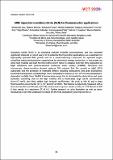Por favor, use este identificador para citar o enlazar a este item:
http://hdl.handle.net/10261/230623COMPARTIR / EXPORTAR:
 SHARE
BASE SHARE
BASE
|
|
| Visualizar otros formatos: MARC | Dublin Core | RDF | ORE | MODS | METS | DIDL | DATACITE | |

| Título: | MBE deposited scandium nitride (ScN) for thermoelectric applications |
Autor: | Rao, Dheemahi; Biswas, Bidesh; Flores, Eduardo CSIC ORCID; Chatterjee, Abhijit; Garbrecht, Magnus; Koh, Yee Rui; Bhatia, Vijay; Pillai, Ashalatha Indiradevi Kamalasanan; Hopkins, Patrick E.; Martín-González, Marisol CSIC ORCID ; Saha, Bivas | Fecha de publicación: | 21-jul-2020 | Citación: | Virtual Conference on Thermoelectrics (VCT) (2020) | Resumen: | Scandium nitride (ScN) is an emerging rocksalt III-nitride semiconductor and has attracted significant interests in recent years for its potential thermoelectric applications, as a substrate for high-quality epitaxial GaN growth and as a semiconducting component for epitaxial singlecrystalline metal/semiconductor superlattices for thermionic energy conversion. In this poster, we show high mobility and high thermoelectric power factor in epitaxial ScN thin films deposited on MgO substrates with plasma-assisted molecular beam epitaxy (PAMBE). Structural and microscopic characterization showed epitaxial 002 oriented ScN film growth on MgO (001) substrates and the presence of extended defects including dislocations and grain boundaries. Electrical measurement exhibited high room-temperature mobility of 127 cm2 /Vs and temperaturedependent mobility from 50-400 K temperature range that is dominated by dislocation and grain boundary scattering. Due to the high mobility and a moderately large carrier concentration (8.6×1019 cm-3 ), ScN films exhibit high Seebeck coefficients (180 µV/K at 950 K) and a large thermoelectric power factor (2.3 × 10-3 W/m K2 at 500K). The thermal conductivity measured with a time-domain thermoreflectance (TDTR) measurement system exhibit a value of 7.33 W/m K at 500 K that results in a maximum ZT of 0.2. Further research on alloy formation as well as nanostructuring is currently underway to reduce the thermal conductivity and improve the ZT. | Descripción: | Resumen del trabajo presentado en el Virtual Conference on Thermoelectrics (VCT), celebrado online del 21 al 23 de julio de 2020 | Versión del editor: | https://conferences.mines.edu/vct2020/wp-content/uploads/sites/5/2020/07/VCT2020-abstract-book.pdf | URI: | http://hdl.handle.net/10261/230623 |
| Aparece en las colecciones: | (IMN-CNM) Comunicaciones congresos |
Ficheros en este ítem:
| Fichero | Descripción | Tamaño | Formato | |
|---|---|---|---|---|
| MBE.pdf | 73,36 kB | Adobe PDF |  Visualizar/Abrir |
CORE Recommender
Page view(s)
186
checked on 23-abr-2024
Download(s)
42
checked on 23-abr-2024
Google ScholarTM
Check
NOTA: Los ítems de Digital.CSIC están protegidos por copyright, con todos los derechos reservados, a menos que se indique lo contrario.
